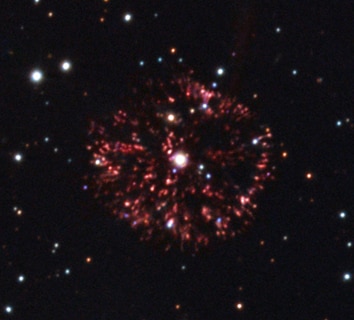Create a free profile to get unlimited access to exclusive videos, sweepstakes, and more!
Desktop Project Part 15: The expanding Fireworks Nebula

[In an effort to clean off the gazillion astronomical pictures I've been collecting on my computer's desktop, I'm posting one per day until they're gone, and my PC heaves a sigh of relief.]
In 1901, an obscure star in the constellation of Perseus suddenly flared into brightness, becoming briefly one of the brightest stars in the sky. Called GK Persei (or Nova Persei 1901), it's an odd beast. While some stars like this just fade away after such an event, even now, more than a century later, GK Persei still suffers through periodic explosions, emitting vast pulses of energy.
In 1902 it was found to have an expanding cloud of gas around it. Adam Block, of the Mt. Lemmon Observatory, put together a wonderful animation showing that nebula expanding over 17 years, from 1994 to 2011:
You can see why it's called the Fireworks Nebula!
This type of system is called a cataclysmic variable star. It's a binary: one of the stars is a white dwarf, an ultra-dense ball of matter that used to be the core of a normal star like the Sun. When that star reached the end of its life, it shed its outer layers, exposing its core to space.
In this case, though, there's another star in close orbit: a swollen red giant, another star nearing the end of its life. The actual physics is quite complicated, but essentially what's happening is material from the red giant is falling onto the white dwarf, where it piles up. The surface gravity of the dwarf is fierce: it can be a hundred thousand times the gravity of Earth! This compresses the infalling material incredibly, so much that when the pile gets big enough it can cause spontaneous nuclear fusion.
The resulting explosion is incredibly violent, and blasts a lot of the material into space. After a while, though, things settle down, and the matter starts piling up again. The cycle repeats. It's not the same every time, as the 1901 nova event shows! That was quite the singular event. So sometimes the star is more violent than others. Recently GK Persei has been acting up again, undergoing brighter flares, though nothing like the 1901 explosion. The good news is that at its distance of 1500 light years it's no danger to us, but that's still close enough to get a great view of it. It's a fantastic example of an aptly-named cataclysmic variable -- that's almost poetic, isn't it? -- and an icon representing the weird ways a star can die.
Related Posts:
Â
- Anybody wanna peanut? (about another white dwarf/red giant binary)
- Spinning white dwarf bombs may lurk the galaxy
- Dwarf merging makes for an explosive combo
- Naked eye nova!


























